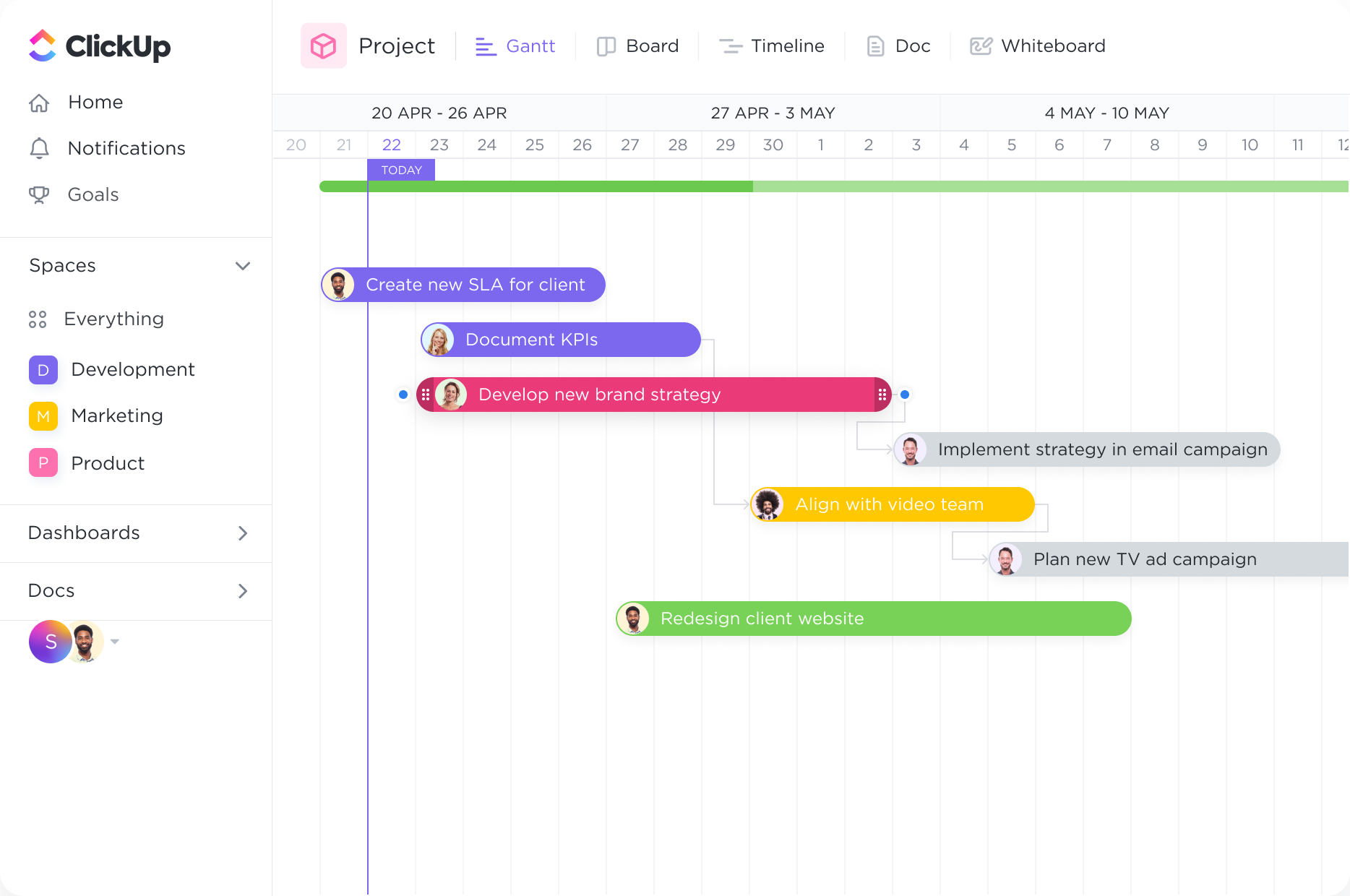Stay ahead of every deadline.
With the Gantt chart's dynamic timeline, you can easily schedule tasks, keep up with project progress, manage deadlines, and handle bottlenecks.
Streamline your bookkeeping tasks with ClickUp's powerful Gantt Chart software. Visualize your projects, track progress, and manage deadlines with ease. With ClickUp, you can create Gantt Charts specifically designed for bookkeepers, allowing you to stay organized, improve efficiency, and deliver projects on time. Take control of your bookkeeping projects and experience the power of ClickUp's Gantt Chart software today.
Free forever.
No credit card.

Trusted by the world’s leading businesses
With the Gantt chart's dynamic timeline, you can easily schedule tasks, keep up with project progress, manage deadlines, and handle bottlenecks.
Intelligent dependency-path tracking shows you where potential bottlenecks might exist to prevent inefficiencies.
Bookkeepers can use Gantt charts to plan and track the process of financial reporting and analysis. They can outline the steps involved, such as gathering financial data, preparing financial statements, and conducting variance analysis. By visualizing the timeline and dependencies of these tasks, bookkeepers can ensure timely and accurate reporting, allowing for better financial decision-making.
Gantt charts can be valuable tools for bookkeepers when creating budgets and forecasts. Bookkeepers can break down the budgeting process into smaller tasks, such as gathering expense data, analyzing historical trends, and projecting future financials. By using a Gantt chart, bookkeepers can allocate timeframes for each task, track progress, and ensure that the budgeting process stays on schedule.
Bookkeepers often face strict deadlines when it comes to tax preparation and filing. Gantt charts can help bookkeepers plan and manage the entire tax process, including gathering necessary documents, calculating deductions, and completing tax forms. By visualizing the timeline and key milestones, bookkeepers can stay organized, meet deadlines, and avoid last-minute rushes during tax season.
Managing accounts payable and receivable involves various tasks, such as invoice processing, payment scheduling, and collections. Gantt charts can assist bookkeepers in creating a timeline for these tasks, ensuring that payments are made on time and outstanding invoices are followed up promptly. By using a Gantt chart, bookkeepers can track progress, identify potential bottlenecks, and maintain a healthy cash flow.
Preparing for a financial audit requires careful planning and coordination. Bookkeepers can use Gantt charts to outline the steps involved in audit preparation, such as gathering supporting documents, reconciling accounts, and conducting internal reviews. By visualizing the timeline and dependencies of these tasks, bookkeepers can ensure that the audit process runs smoothly and that all required information is readily available.
Bookkeepers often need to migrate financial data from one system to another or upgrade existing systems. Gantt charts can help bookkeepers plan and manage these complex projects by breaking them down into smaller tasks, such as data extraction, cleansing, and validation. By using a Gantt chart, bookkeepers can allocate timeframes for each task, track progress, and ensure a seamless transition without disrupting day-to-day operations.
Gantt chart software can help bookkeepers by visually organizing and tracking their tasks and projects. It allows them to prioritize tasks, set deadlines, and allocate resources efficiently. This enables bookkeepers to manage their workload effectively, stay on schedule, and ensure that all financial tasks are completed accurately and on time.
Bookkeepers should look for Gantt chart software that offers features such as task management, resource allocation, and dependencies tracking. Additionally, it should provide the ability to set deadlines and milestones, generate progress reports, and facilitate collaboration and communication among team members. Integration with other accounting and project management tools can also be beneficial for bookkeepers.
Bookkeepers should consider Gantt chart software that integrates seamlessly with their existing bookkeeping tools, such as accounting software or project management platforms. This ensures efficient data transfer, eliminates manual data entry, and enables real-time updates. Additionally, compatibility with common file formats, such as CSV or Excel, allows for easy import/export of financial data.